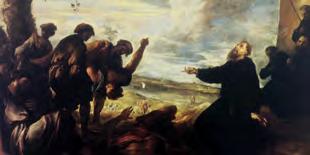



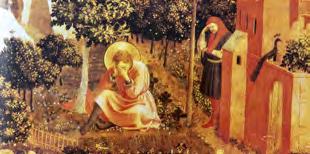
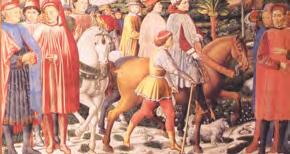









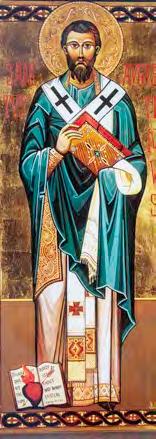
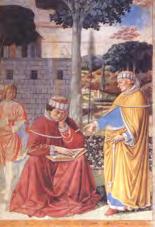


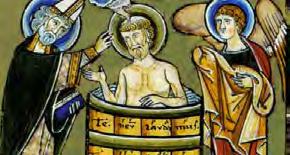
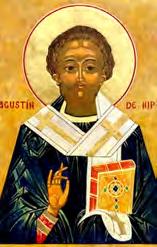

Discover the many faces of St. Augustine of Hippo in this inspiring exhibition, where art brings his life and message into focus. Born in 354 AD in North Africa, Augustine has had a profound and lasting impact on the Church, Christianity, theology, philosophy, and religious communities and missionaries around the world and in every context.
From the earliest known image of Augustine, dating back to the 6th century, to traditional iconography and contemporary works like An Unlikely Aquilegia: North African Saint of Hippo, commissioned by Villanova University in 2022, each piece reflects the enduring portrayal of Augustine and the communities his legacy has impacted.
For centuries, European Christian art often depicted biblical and early Christian figures with European features, regardless of their geographic and ethnic origins. Whether depicted with his restless heart, bishop’s miter and crosier, Rule of Life, or the divine illumination of Christ’s light, explore how centuries of artists have interpreted the person of Augustine and his message of Truth, Unity, and Love.

Title: Unknown
Artist: Unknown
Location: Lateran Basilica in Rome, Italy
Date: 6th Century
Style: Fresco
This fresco is the oldest surviving image of Augustine and depicts Augustine in the conventional manner of medieval saint portraiture - seated with a book that represents his scholarly authority and designation as a Doctor of the Church.
Rather than attempting realistic individual characterization, the artwork follows the medieval artistic tradition of using symbolic elements to communicate the saint’s spiritual significance and intellectual contributions.
This modern depiction of St. Augustine, reflects both the enduring legacy and the continual reimagining of his image in art. Painted in 1961, the work belongs to a period when artists sought to connect ancient spiritual themes with contemporary expression.
This painting invites viewers to contemplate Augustine’s deep inner journey toward understanding God and truth—an intellectual and spiritual voyage that has inspired believers and thinkers for centuries. The style and date place the work in the context of mid-20th-century religious art, a time when tradition met modernity.
The presence of this portrait in the Consolazione Church in Palermo continues to honor Augustine’s role as a guiding figure in Christian thought and personal transformation.
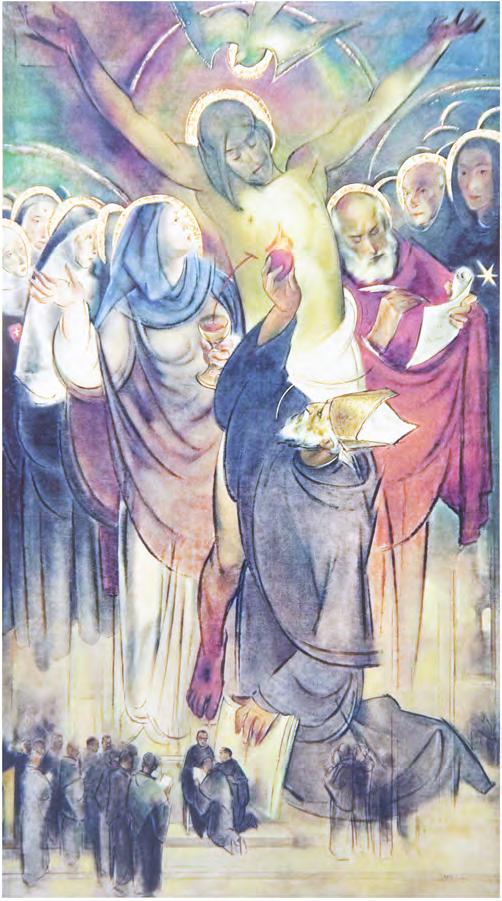
Location: Consolazione Church in Palermo, Italy
Date: 1961
Style: Oil

Augustine is Taken to School by His Parents
Location: Chiesa di Sant’Agostino (Church of Saint Augustine) in San Gimignano, Italy
Date: 1464-1465
Style: Renaissance style fresco
The artwork depicts a scene from Augustine’s childhood, showing the moment when his parents bring him to school for his education. This represents an important biographical detail from Augustine’s early life, as his education would prove crucial to his later development as one of Christianity’s greatest theologians.
The fresco is executed with elaborate architectural settings featuring classical columns, arches, and decorative elements. The scene takes place in what appears to be a grand public space or school courtyard with impressive marble architecture. The composition includes multiple figures - Augustine’s parents presenting him to teachers, along with other children and adults in the scene.
The figures are dressed in rich, colorful Renaissance clothing - reds, blues, and earth tones - reflecting the fashion and social customs of 15th-century Italy rather than 4th-century North Africa.
This painting shows St. Monica and St. Augustine, mother and son, discussing the kingdom of heaven. In Book Nine of his Confessions Augustine described how, shortly before his mother’s death, the two of them had a profound spiritual conversation and vision at Ostia, talking of spiritual matters: ‘we were seeking between ourselves in the presence of the Truth, which You are, of what nature the eternal life of the saints would be.’
The saints sit side-by-side with Monica holding Augustine’s hand in hers, as they raise their eyes to heaven and consider its mysteries. They are shown in a moment of spiritual transcendence, both gazing upward with expressions of divine contemplation. The painting captures their shared spiritual journey, making it both a personal and universal representation of religious devotion.
Scheffer stresses the closeness of the emotional and spiritual bond by stripping the picture of non-essentials. Mother and son are clothed in the simplest of Roman gowns with a background of undecorated masonry, soft blue sky and sea. The light that shines on them is both that of the evening sunset and of heaven itself.

Location: National Gallery in London, England
Date: 1854
Style: Dutch-French Romantic

Location:
Date: c. 17th century
Style: Oil on canvas
In this luminous Baroque masterpiece, St. Augustine is depicted in a moment of spiritual ecstasy, beholding a vision of the Virgin Mary and the Christ Child. Surrounded by soft light and heavenly clouds, Augustine is shown lifted in prayer, bathed in divine presence. His expression and posture reflect awe, humility, and deep devotion. The Virgin Mary holds the Christ child, both surrounded by a warm, golden celestial light and accompanied by cherubs or putti floating in the clouds.
Murillo, known for his tender and emotive religious imagery, captures the mystical intensity of Augustine’s spiritual life. The Virgin’s gentle gaze and the child’s innocence emphasize divine love and grace—themes central to Augustine’s theology.
Painted during the Spanish Golden Age, this work invites viewers into a moment of transcendent communion, where faith and vision meet. It reflects Augustine not just as a theologian, but as a saint moved and transformed by divine encounter. This type of mystical vision painting was popular in Counter-Reformation art, designed to inspire devotion and make the divine mysteries more tangible to viewers. The work exemplifies Murillo’s ability to convey both the supernatural and deeply human aspects of religious experience.
This painting shows Augustine as a contemplative scholar seated in what appears to be a study or library setting. He’s wearing dark robes (likely an Augustinian habit) and is depicted with European featurespale skin, beard, and a thoughtful expression as he holds a writing instrument, suggesting his role as a theologian and author.
There are books visible in the scene, emphasizing Augustine’s intellectual legacy. This work reflects the traditional European artistic approach to depicting saints that was common before the recent movement toward more historically accurate ethnic representation. It shows Augustine as he was often imagined in European religious art - as a European monk-scholar rather than the North African he actually was. This makes it an interesting contrast to the contemporary works that deliberately emphasize his Berber heritage.

Date: 1949
Style: Classical European Oil

Location: Pinacoteca Vaticana, Vatican in Rome, Italy
Date: 1394-1416
Style: Tempera on panel
This early 15th-century painting by Niccolò di Pietro Gerini depicts the moment St. Augustine is baptized by Bishop Ambrose, marking a pivotal point in Augustine’s spiritual transformation. Rendered in the Italian Gothic style, the work presents a solemn and ceremonial scene emphasizing the sacred rite of baptism. Ambrose, vested as bishop, baptizes Augustine who is portrayed with humility and reverence.
Gerini’s detailed composition includes architectural elements and other figures witnessing the event, reflecting the importance of the Church in Augustine’s conversion. Housed in the Vatican Pinacoteca, this masterpiece is part of the vibrant Italian devotional art tradition, capturing both theological significance and ritual solemnity in the early Renaissance period.
The style or medium in this painting is tempera on panel, a common medium before the widespread use of oil paints in Italy, consistent with Gerini’s late Gothic style and practices around the early 15th century.
Francisco Rizi’s Saint Augustine is a powerful Baroque portrait of the revered Church Father, painted around 1665. Likely part of a series of saint portraits, possibly for an Augustinian convent, the work reflects Rizi’s mature style—rich in color, dramatic in lighting, and emotionally expressive.
The saint is depicted with traditional iconography, emphasizing his role as a theologian and bishop. Once incorrectly attributed to Valdés Leal, it was correctly attributed to Rizi in 1944. The painting exemplifies Spanish Counter-Reformation art, designed to inspire devotion through vivid, spiritually charged imagery.

Location: Museo Lazaro
Date: 17th century
Style: Spanish Baroque
Medium: Oil on panel
in Madrid, Spain
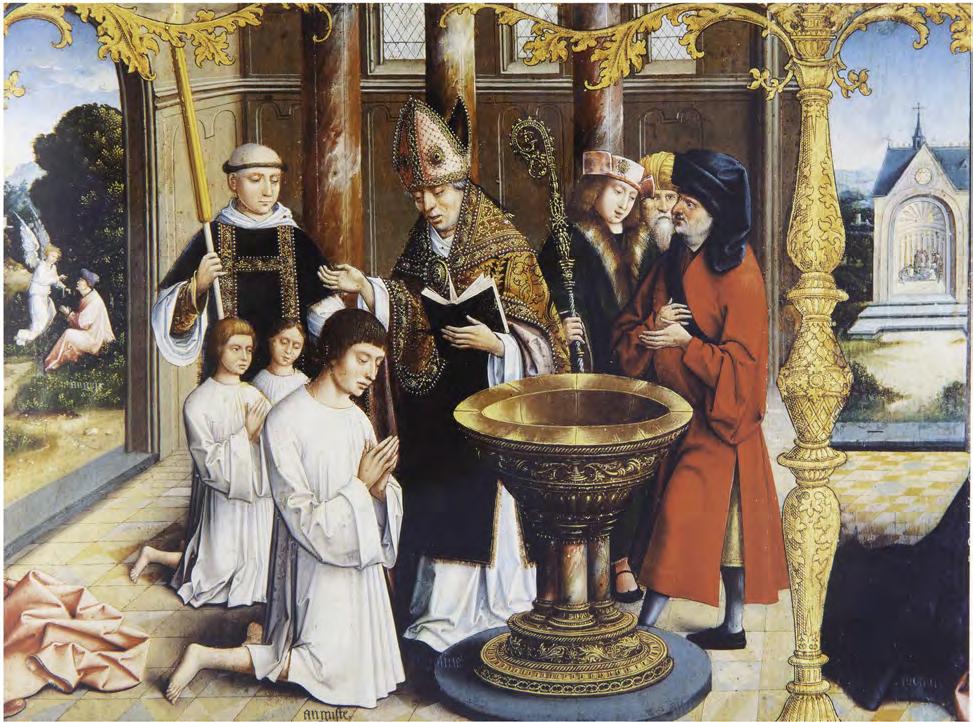
Title: The Baptism of St. Augustine
Artist: Jan van Scorel
Location: Church of St. Stephen in Jerusalem, Israel
Date: c. 1520
Style: Oil on panel
This artwork depicts the historic baptism that took place on Easter Vigil in 387 CE. This is a significant moment in Christian history, as it represents Augustine’s formal entry into the Christian faith under the guidance of St. Ambrose, the Bishop of Milan.
The scene centers around a large baptismal font where the sacrament is taking place. St. Ambrose, identifiable by his vestments and mitre, is performing the baptism while Augustine appears to be kneeling or standing at the font.
This baptism was historically significant because Augustine went on to become one of the most influential theologians in Christian history. St. Ambrose played a crucial role in Augustine’s conversion, and their relationship represents an important mentorship in early Christianity.
The artist has depicted Augustine with European features, following the traditional artistic conventions of the period when this was painted, rather than representing his actual North African heritage.
The composition is a complex religious scene with multiple narrative elements arranged across different spatial planes.
This painting represents Augustine’s vision in which he saw a child trying to empty the sea into a hole dug in the sand. When Augustine told him that this was impossible, the child, a messenger from God, replied that Augustine’s attempt to explain the Trinity was an equally impossible task. Garofalo has made the child perched on a mound of sand Christ himself, his head crowned with a halo of rays of light.
Garofalo’s depiction of this episode is unusual in that it also includes the holy family, Saint Catherine and Saint Stephen (on the shore in the middle distance).
This type of sacra conversazione (sacred conversation) was popular during the Renaissance, bringing together saints and holy figures in a single devotional image despite their different historical contexts.

Title: Saint Augustine with the Holy Family and Saint Catherine of Alexandria (‘The Vision of Saint Augustine’)
Artist: Benvenuto Tisi da Garofalo
Location: National Gallery in London, England
Date: c. 1520
Style: Oil on wood

Artist: Unknown
Location: Residencia Tomas Camara in Madrid, Spain
Date: 2001
Style: Oil on wood
This painting located in Residencia Toma, Madrid, is an oil-on-wood work that presents a modern interpretation of the revered saint.
The artist combines traditional religious themes with contemporary artistic expression. This piece likely reflects Augustine’s profound spiritual and intellectual legacy, capturing his contemplative nature and theological significance through thoughtful composition and rich oil technique.
The work continues the long tradition of portraying Augustine as a foundational figure in Christian theology while engaging a 21st-century aesthetic sensibility.
The painting shows St. Augustine in his robes, seated at his writing desk in a moment of divine inspiration. The dramatic lighting - with golden light streaming from above and the presence of the burning flame (representing the Holy Spirit) - emphasizes the supernatural nature of his inspiration. This illustrates the belief that Augustine’s theological writings were divinely guided.
In the painting, Saint Augustine is depicted with a quill in one hand, as if he was writing a book, and a burning heart in the other hand. He looks above where a light flows and says “Veritas” which means “Truth.” St. Augustine in his one of the most important books called Confessions says: “You have made us for yourself, O Lord, and our hearts are restless until they rest in you.” Meaning, the human heart is restless until it unites with God. So the burning heart in the painting shows the divine energy of God that dwells in the humans’ hearts. It leads people’s souls instinctively towards God.

Location: Los Angeles County Museum of Art in Los Angeles, CA
Date: c. 1645
Style: Oil on canvas

Location: Musée des Beaux Arts in Nantes, France
Date: 1748
Style: Rococo, oil
The painting depicts the final moments of St. Augustine’s life, showing the dying saint on his deathbed surrounded by followers and clergy. Augustine appears as an elderly, bearded figure in white robes, lying on a bed with his hand extended. The composition captures the miraculous healing power attributed to the saint even in his final moments - several figures around the bed appear to be sick or afflicted individuals seeking his blessing and healing touch.
The dramatic lighting, characteristic of Baroque influence still present in early Rococo work, illuminates Augustine’s pale figure against the darker surroundings. The artist has used warm, earthy tones with touches of gold and white to create a sense of both solemnity and divine presence.
Van Loo has masterfully captured the emotional intensity of the momentthe expressions of hope, faith, and desperation on the faces of those gathered around the saint, while Augustine himself appears serene despite his physical suffering. This painting exemplifies the Rococo period’s approach to religious subjects, maintaining spiritual gravitas while showing more naturalistic human emotion and physical detail than earlier periods.
This contemporary religious painting depicts St. Augustine seated on a cathedra (bishop’s throne), emphasizing his role as a bishop and Doctor of the Church. The work shows a distinctly modern artistic approach while maintaining traditional religious iconography.
Augustine is portrayed in episcopal vestments with rich colorsgolden yellow robes with purple accents, and what appears to be a bishop’s mitre. He holds an open book, likely representing his extensive theological writings, while behind him is a golden halo, indicating his sainthood.
The painting style combines realistic figurative elements with somewhat stylized, angular forms that give it a contemporary feel while still being reverent to the subject matter. The use of bold colors - the bright blues in the background, the golden yellows, and deep purples - creates a vibrant, luminous effect.
As a 1993 work housed in Vatican premises, this painting represents modern religious art that maintains continuity with traditional Christian iconographic conventions while employing contemporary artistic techniques.
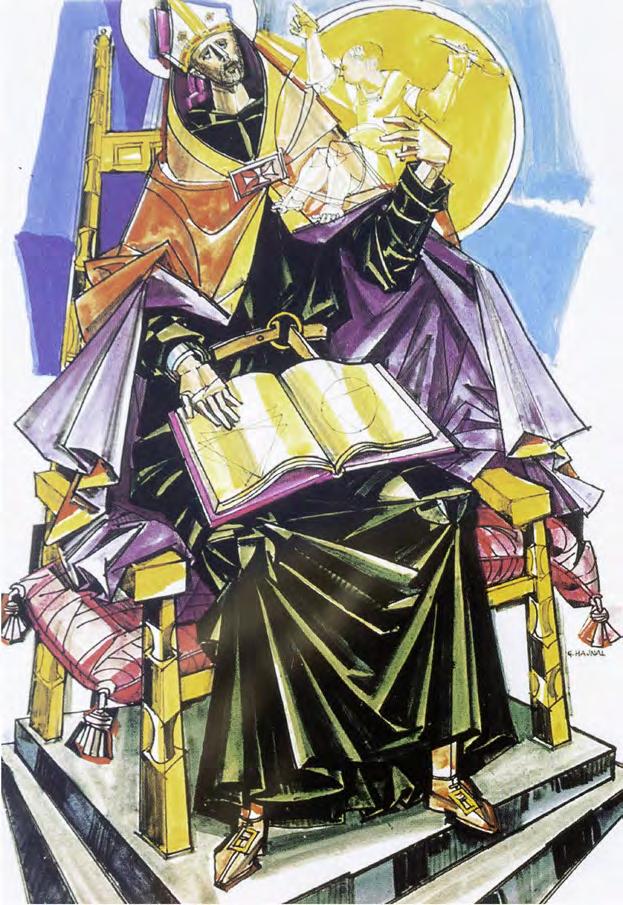
Location: Generalate O.S.A., Vatican in Rome, Italy
Date: 1993
Style: Contemporary oil

Title: Saint Augustine Healing the Sick
Artist: Joseph Parrocel
Location: Musée des Beaux Arts in Nantes, France
Date: 17th century
Style: Oil painting
The painting depicts a dramatic outdoor scene where St. Augustine is shown performing miraculous healings. The composition is divided into two main groups: on the left, a cluster of afflicted people - some appearing to be suffering from various ailments or disabilities - who have come seeking the saint’s healing touch. Their poses and expressions convey desperation, hope, and physical suffering.
On the right side of the composition stands St. Augustine, dressed in dark robes, with his hands raised in a gesture of blessing or prayer. His serene, commanding presence contrasts with the urgent need of the supplicants. Behind him stands another religious figure.
The artwork vividly captures a moment of compassion and miraculous healing attributed to St. Augustine, highlighting his role as a spiritual healer and intercessor. Parrocel’s dynamic composition and expressive figures emphasize the saint’s active engagement with the suffering, reflecting Baroque sensibilities with dramatic gestures and emotional intensity.
This work shows Augustine as a scholar in his study, wearing the orange robes of an Augustinian monk. He’s depicted in a contemplative pose, surrounded by books and scholarly materials, which reflects his role as one of the most important theologians and philosophers in Christian history. The architectural setting with its classical columns and rich colors is characteristic of Botticelli’s Renaissance style.
The Church of Ognissanti houses this work as part of a larger fresco cycle. Botticelli was commissioned to paint this along with other frescoes in the church, making it an important example of Renaissance religious art in its original architectural context.

Date: 1480
Style: Fresco
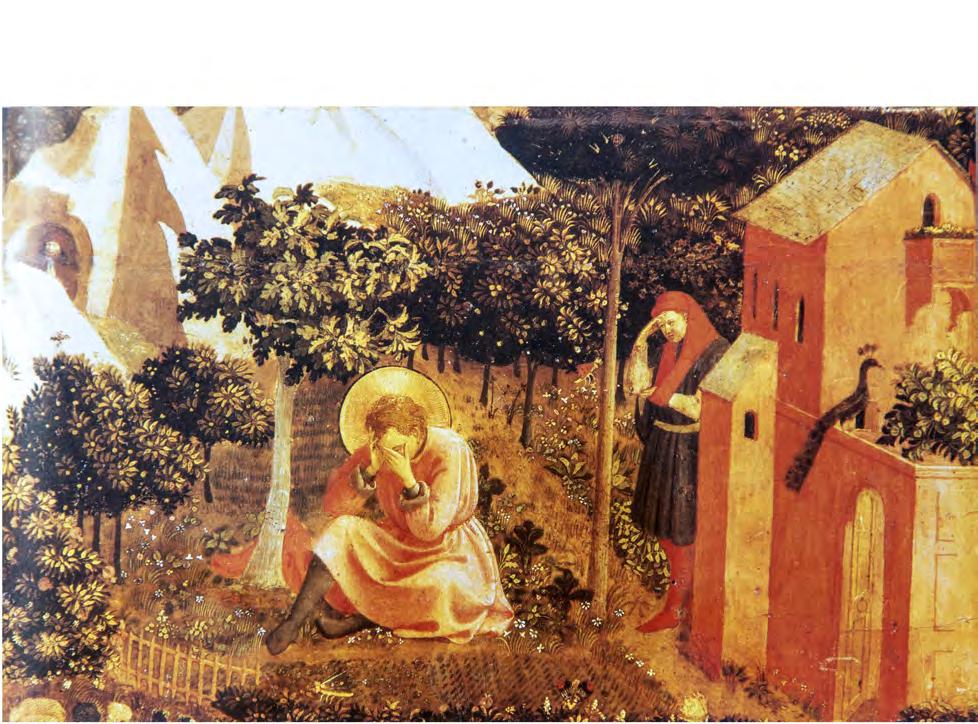
Title: Saint Augustine’s Conversion
Artist: Fra Angelico
Location: Musée Thomas-Henry in Cherbourg, France
Date: 15th Century
Style: Unknown
The painting shows a pivotal moment from Augustine’s spiritual journey - his famous conversion experience in a garden in Milan in 386 CE. According to Augustine’s Confessions, he heard a child’s voice saying “tolle lege” (take and read), which prompted him to open the Bible and read a passage from Paul’s letter to the Romans that led to his conversion to Christianity.
Augustine is depicted in golden/yellow robes with a halo, kneeling in what appears to be a garden setting with lush foliage and flowering plants.
Fra Angelico (c. 1395-1455) was a Dominican friar and painter known for his deeply spiritual religious works. The golden palette and formal composition emphasize the sacred nature of Augustine’s conversion experience.
The artwork shows St. Augustine (identifiable by his vestments and central position) surrounded by several deacons or clerical figures.
The composition is arranged in a hierarchical manner typical of medieval religious art, with Augustine prominently seated and holding what appears to be a book or manuscript, symbolizing his role as a Doctor of the Church and his scholarly contributions to Christian theology. The figures around him are likely his clerical companions or disciples, also shown with books, emphasizing the scholarly and teaching aspects of Augustine’s ministry.
The artwork features the characteristic style of medieval manuscript illumination, with rich colors (particularly the green and gold tones), decorative borders, and symbolic rather than naturalistic representation.
Above the figures, there appears to be a divine or heavenly element with text, suggesting Augustine’s spiritual authority and connection to divine wisdom.
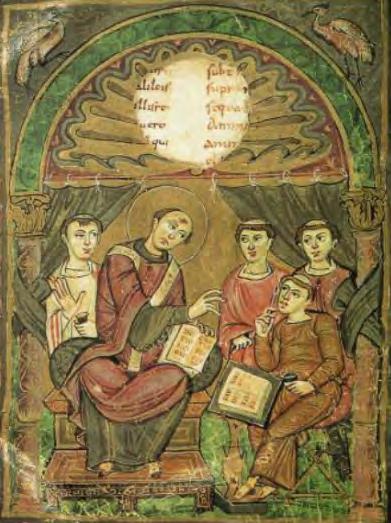
Title: Saint Augustine and Deacons
Artist: Unknown
Location: Berlin Staatsbibliothek in Berlin, Germany
Date: 1676
Style: Medieval

Title: Sant’Agostino Artist: Unknown
Location: Palantine Chapel in Palermo, Italy
Date: 1154-1166
Style: Medieval Mosaic
This mosaic shows Augustine in full regalia - wearing ornate bishop’s vestments with a distinctive cross-patterned pallium (the white stole with black crosses worn by archbishops). He has a dark beard and is holding what appears to be a book or gospel, symbolizing his role as a Doctor of the Church and his theological writings.
The Latin inscriptions “SANCTVS” and “AVGVSTINVS” identify the figure. This work is part of the magnificent mosaic program in the Palatine Chapel, which was built during the Norman period in Sicily and represents a fusion of Byzantine, Islamic, and Western artistic traditions.
This mosaic would have been created by skilled Byzantine craftsmen working in Palermo during the reign of the Norman kings of Sicily, making it a significant example of 12th-century religious art in the Mediterranean world.
The artwork depicts St. Augustine in his study, engaged in the act of writing. He is shown wearing dark monastic robes with a golden halo, seated at a wooden desk or lectern with an open book or manuscript before him. The composition is framed within a distinctive quatrefoil decorative border, which was a common format for Giotto’s work in the Scrovegni Chapel.
Giotto’s treatment shows Augustine as a contemplative scholar and theologian, emphasizing his role as one of the great Doctors of the Church and highlighting his prolific literary output.
The simple but powerful composition focuses attention on Augustine’s scholarly activity, reinforcing his reputation as one of Christianity’s most important theological writers.
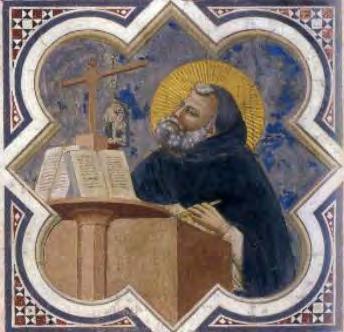
Location: Scrovegni Chapel in Padua, Italy
Date: 1303-1305
Style: Fresco
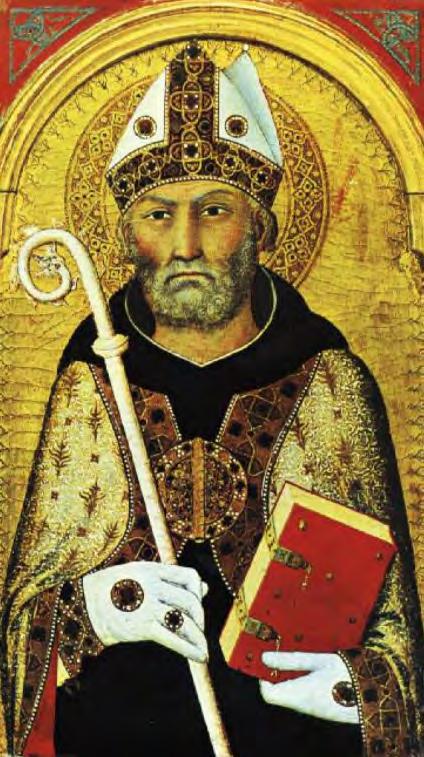
Location: Fitzwilliam Museum in Cambridge, England
Date: 1322-1331
Style: Gothic International
The painting depicts St. Augustine in his role as Bishop of Hippo, wearing full regalia including an ornate mitre decorated with intricate patterns and a luxurious cope (ceremonial cloak) with rich golden brocade. He holds a bishop’s crosier (pastoral staff) in one hand and a red book in the other, symbolizing both his ecclesiastical authority and his role as a Doctor of the Church and prolific theological writer.
The painting features the characteristic gold background typical of medieval religious art, which creates a divine, otherworldly atmosphere. Martini’s refined technique is evident in the detailed rendering of the textiles, the careful modeling of Augustine’s face, and the overall elegance of the composition.
The artwork shows Augustine with a golden halo and wearing vestments - ornate robes with detailed patterns in red, white, and gold. He appears to be holding a scroll or book, which likely contains the referenced quote from his famous autobiographical work Confessions
Nancy Oliphant is a contemporary iconographer, and this piece represents a modern creation in the ancient tradition of religious iconography. The style follows classical icon conventions with its formal pose, symbolic use of gold, and spiritual rather than naturalistic representation.
This icon depicts Augustine with features that appear to reflect his North African heritage, continuing the trend toward more historically accurate representation of this important early Christian theologian and saint.

Location: Unknown
Date: late 20th or early 21st century
Style: Byzantine icon style

Artist: Unknown
Location: St. Augustine By-the-Sea Church in Santa Monica, CA
Date: Unknown Style: Icon
The artwork explicitly identifies Augustine as reflecting his North African Berber heritage, and shows Augustine in traditional vestments - red and white robes with ornate gold embroidery and a distinctive black and white cross pattern on the chest. He’s wearing a golden halo and is holding a book, likely referencing his extensive theological writings. The book appears to have text that might read “CIVITAS DEI” (City of God), one of his most famous works.
The background depicts a stylized cityscape and architectural elements that evoke both ancient North African and Mediterranean settings.
This artwork deliberately represents Augustine with features that reflect his actual ethnic and geographic origins. This represents a shift away from traditional European depictions of the saint toward more historically accurate representations that acknowledge his North African Berber heritage.
This is an icon of St. Augustine completed on August 28, 2013. The icon was presented to Pope Francis on the occasion of the opening of the General Chapter of the Order of St. Augustine and is located at the Church of St. Augustine in Rome, Italy.
The artwork follows traditional Byzantine iconographic style with a golden background and formal composition. Augustine is depicted with a golden halo and the Greek abbreviations “SAN AGUSTIN” and “DE HIPONA” (St. Augustine of Hippo) flanking his head. He’s wearing dark vestments with an ornate white stole decorated with gold patterns.
Augustine is shown holding a book, likely representing his theological writings, while his other hand is positioned in a gesture of blessing or teaching. The icon maintains the tradition of depicting Augustine with features that reflect his North African heritage, showing him with darker skin and curly hair.
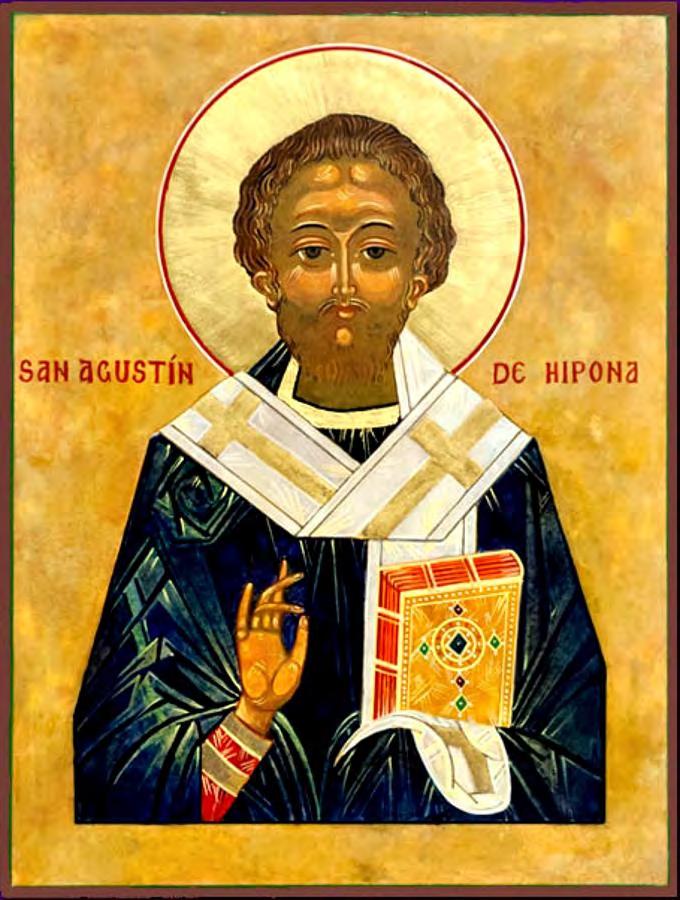
Location:
Date: 2013
Style: Icon

Location:
Date: 2004
Style: Tapestry
The artwork depicts St. Augustine of Hippo wearing traditional religious vestments. He has a golden halo, indicating his sainthood. He is holding a book, which is fitting given Augustine’s extensive theological writings including works like Confessions and City of God
The significance of Augustine’s darker skin tone in this tapestry relates to historical accuracy and cultural representation. St. Augustine of Hippo (354-430 CE) was born in North Africa, specifically in what is now Algeria, and would have had the appearance typical of North African Berber populations of his time.
This tapestry by John Nava appears to be making a more historically accurate representation of Augustine as a North African man, helping viewers understand that early Christianity was a diverse, multicultural movement that included people from across the Roman Empire, including many from Africa and the Middle East.
The painting depicts St. Augustine of Hippo in his role as a bishop, wearing vestments including a mitre and ornate blue and gold robes. He is shown holding an open book, which likely represents his monastic rule - the guidelines he established for religious communities. The golden background and the presence of angels in the upper corners are typical of Gothic religious art of this period.
This work illustrates St. Augustine’s importance not just as a theologian and philosopher, but also as the founder of a monastic order. The “Rule of Saint Augustine” became one of the most influential monastic rules in Western Christianity, governing the lives of Augustinian canons and friars.

Location:
Date: c. 1370-1380
Style: Late Medieval Painting

Title: Sant’Agostino
Location: Church of San Giacomo Maggiore in Bologna, Italy
Date: c. 1344
Style: Italian Gothic
The artwork depicts Saint Augustine as a bishop, wearing elaborate vestments including a richly decorated mitre and an ornate cope with intricate patterns in green and gold. Paolo Veneziano, a prominent Venetian painter of the 14th century, depicted Sant’Agostino (Saint Augustine) in several works, most notably as part of polyptychs (multi-panel altarpieces).
This work is part of the Gothic tradition in Italian painting, where saints were depicted with the symbols of their office and achievements. The formal, frontal presentation and the use of rich materials in the vestments emphasize Augustine’s authority and sanctity, while the book he holds reinforces his role as one of the greatest theological writers and Church Fathers. The book he’s holding could symbolize his vast literary contributions to Christian theology and his role as a learned scholar and doctor of the Church.
János Hajnal (1913–2010) was a Hungarian-born, Italian-naturalized artist celebrated for his glass art, mosaics, and illustrations, often exploring sacred themes. Among his notable religious illustrations, Hajnal created a work titled “Augustine and the Child.” This piece depicts the legend associated with St. Augustine—a powerful scene where Augustine, struggling to comprehend the mystery of the Holy Trinity, encounters a child attempting to pour the vast sea into a small hole in the sand. The child tells Augustine that it’s easier to fit the ocean into that hole than for the human mind to completely grasp the Trinity.
His illustrations, including “Augustine and the Child,” were featured in the book “Il Fascino di Dio,” which collected tempera works of Augustinian saints commissioned to Hajnal for the Augustinian order around the year 2000.

Location: Office of Augustinian Postulator of Causes in Rome, Italy
Date: c. 1993
Style: Modern

Location: Villanova University in Villanova, PA
Date: 2022
Style: Oil painting
This vibrant, contemporary depiction of St. Augustine is rendered in a bold, modern artistic style. The artwork shows Augustine with distinctly African features - darker skin, curly hair, and a full beard - explicitly representing his North African heritage in a way that contrasts sharply with traditional European depictions.
The painting uses brilliant, saturated colors with Augustine wearing purple and red robes that have a luminous quality. He’s depicted with a large golden halo and appears to be holding what looks like a ceremonial staff or bishop’s crosier with an ornate circular top, emphasizing his role as a bishop and church father.
This contemporary artistic approach represents a significant departure from classical religious art traditions. The artistic choice to prominently feature Augustine’s African identity more accurately according to his actual ethnic and geographic origins.
The overall effect presents Augustine as a powerful figure who bridges ancient wisdom and modern identity.